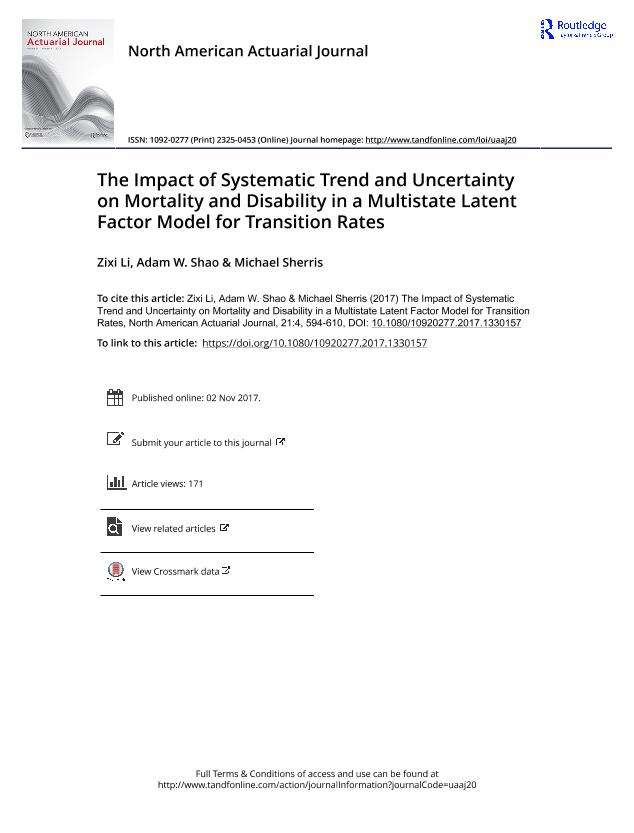The Impact of systematic trend and uncertainty on mortality and disability in a multistate latent factor model for transition rates

Contenido multimedia no disponible por derechos de autor o por acceso restringido. Contacte con la institución para más información.
| Tag | 1 | 2 | Valor |
|---|---|---|---|
| LDR | 00000cab a2200000 4500 | ||
| 001 | MAP20180003998 | ||
| 003 | MAP | ||
| 005 | 20180213171131.0 | ||
| 008 | 180207e20171204esp|||p |0|||b|spa d | ||
| 040 | $aMAP$bspa$dMAP | ||
| 084 | $a6 | ||
| 100 | $0MAPA20180001321$aLi, Zixi | ||
| 245 | 1 | 4 | $aThe Impact of systematic trend and uncertainty on mortality and disability in a multistate latent factor model for transition rates$cZixi Li, Adam W. Shao, Michael Sherris |
| 520 | $aMultiple state functional disability models do not generally include systematic trend and uncertainty. We develop and estimate a multistate latent factor intensity model with transition and recovery rates depending on a stochastic frailty factor to capture trend and uncertainty. We estimate the model parameters using U.S. Health and Retirement Study data between 1998 and 2012 with Monte Carlo maximum likelihood estimation method. The model shows significant reductions in disability and mortality rates during this period and allows us to quantify uncertainty in transition rates arising from the stochastic frailty factor. Recovery rates are very sensitive to the stochastic frailty. There is an increase in expected future lifetimes as well as an increase in future healthy life expectancy. The proportion of lifetime spent in disability on average remains stable with no strong support in the data for either morbidity compression or expansion. The model has widespread application in costing of government-funded aged care and pricing and risk management of long-term-care insurance products. | ||
| 650 | 4 | $0MAPA20080555306$aMortalidad | |
| 650 | 4 | $0MAPA20080579258$aCálculo actuarial | |
| 650 | 4 | $0MAPA20080602437$aMatemática del seguro | |
| 773 | 0 | $wMAP20077000239$tNorth American actuarial journal$dSchaumburg : Society of Actuaries, 1997-$x1092-0277$g04/12/2017 Tomo 21 Número 4 - 2017 , p.594-610 |

